#sedum-lineare
Text
heads up, seven up!
"Rules for those who want to participate: post 7 lines from a wip of yours and tag some other people!!!!" Thanks @sedum-lineare! I have many many Thoughts on ecology and fungi and humanity which I’m hoping will be a fic soon. Ish.
She reads about the fungi that live with humans.
The microbiome in her gut and on her skin that keeps her healthy.
The penicillium that saved Joel's life.
The microbiome which mimics that of the people you live with, and how mothers (parents, she corrects in her head) pass on some beneficial fungi and bacteria to their children during birth.
If only she could convince her Cordyceps to share and mix with Joel's microbiome in the same way, tell it he is family and a friend, and if she thinks of him as such Cordyceps should too, and protect him too.
It's a gentle fantasy, one she's angry to still think about, when she learns the truth.
Angry at Joel for taking the choice away and not treating her like an adult, angry that the doctors were going to separate her and him and the fungus from each other so violently, so completely.
@rustandruin @drumlincountry @doodleborg no pressure just if you have some writing Thots to share!
#*me waving my hand above my head like the eric andre meme* what if fungus but like Venom (2018)#the scene in Venom where Venom and Eddie are separated and everyone is having a bad time but it's me after some antibiotics#anyway can you tell i read i contain multitudes and had feelings about it#catch me getting punched in the tlou universe because someone would go fuck fungi we should kill all fungi all my homies hate fungi#and i would be there like well actually-#having a fungal infection and wanting to bite people about it is a very valid feeling actually im with the cordyceps on this one#tlou#my writing#tag games#sedum-lineare#also did you know the real ophiocordyceps doesn't target the brain of the insects it infects at all just their muscles#so potentially they know what's going on or are at least aware that something is very wrong#and other ants in the colony will take infected ones away to try and save the rest of the colony#isn't that a fun thought#throwback to that time i tried to convince piratearrowxab it would be a good idea to buy some cordyceps as a house fungi because there are#lots of varieties of the none zombie-fying kind but i was vetoed
3 notes
·
View notes
Text

Sedum lineare / Carpet Sedum at the Sarah P. Duke Gardens at Duke University in Durham, NC
#Sedum#Crassulaceae#Stonecrop#Flowers#succulents#Nature photography#photography#photographers on tumblr#Sarah P. Duke Gardens#Duke Gardens#Duke University#Durham#Durham NC#North Carolina#🌺🌻#Plants#Sedum lineare#Carpet Sedum#Needle Stonecrop#sea urchin
8 notes
·
View notes
Text


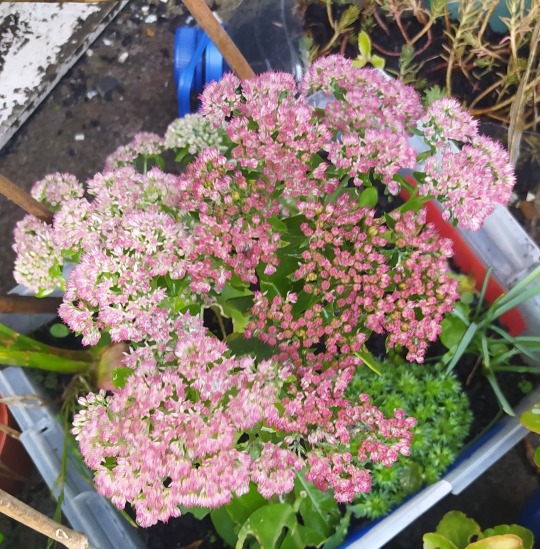

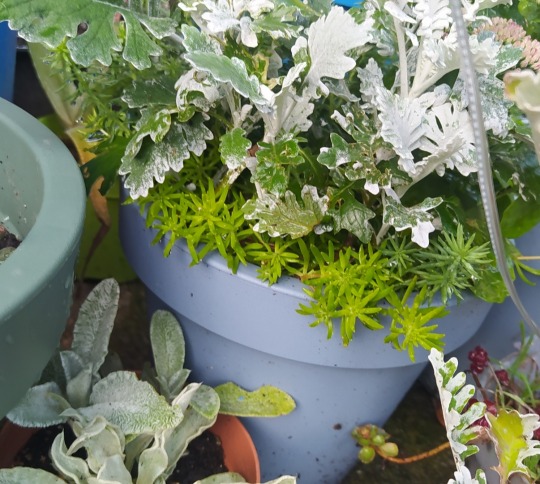

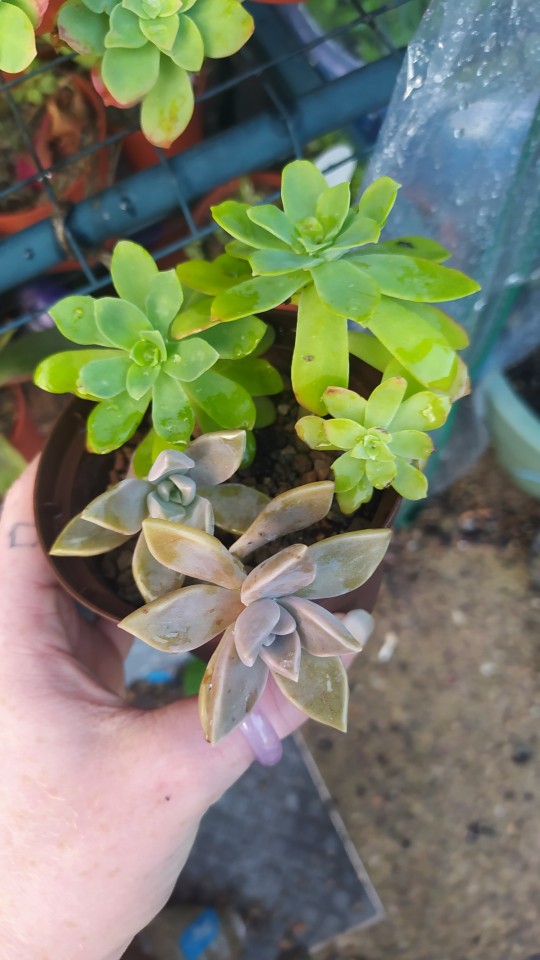

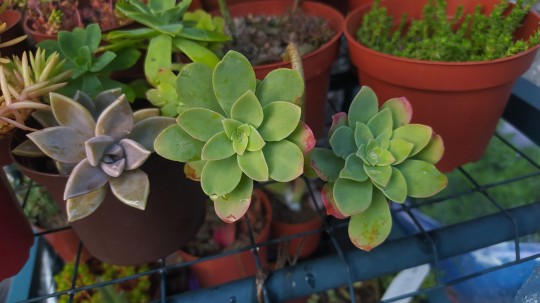
sempervivum, most likely gold nugget
orpine flowers, hytotelephium telephium
silver ragwort + carpet sedum
orpines, silver ragwort + sedum rupestre (the carpet sedum is hidden underneath)
sedum palmeri + graptopetalum paraguayanese, received in the post
^ same, + carpet sedum again
these sedum palmeri i brought back from Amsterdam, and the graptopetalum is the same as pictured above
#personal#plantblr#succulentblr#plants#succulents#orpines#hytotelephium telephium#sedum lineare#carpet sedum#silver ragwort#sedum rupestre#sedum palmeri#graptopetalum paraguayanese#ghost plant#my plants
14 notes
·
View notes
Text

駅前のお花屋さんで咲いていた、
「オノマンネングサ(雄の万年草)」の黄色い花。
別名:セダム・リネアレ。
欧文名:Sedum lineare
4 notes
·
View notes
Text
Haven't done a plant update in awhile but they're doing great!!

My string of hearts is being weird but the rattlesnake and spiders are doing well!! Also my mom got me a cute air plant with a pumpkin holder for my birthday <3 I hope it will be happy here :)

My funny sedum guy is mostly okay but one section is struggling a bit, I'm starting more peas because I love them so much and some daisies :D my basil is growing very well!!! I'm so proud of them same with the aloe<3
I'm also starting lots of seeds but they're not out of the dirt yet

mY PRIZED PLANT VSOH 🫶 they're doing the thing after they arrive through the mail where they drop alot of leaves but theyre also growing so fast!!!! I love them:)
Also my bigger pea plants :D the biggest one has taught me the important of planting multiple together because she cannot keep herself up
And my tiger tooth aloe !!! They are recovering from having no light in my living room :[
#plants#indoor plants#string of hearts#basil plant#aloe plant#sedum lineare#pea plant#calatheas#air plants
0 notes
Text
Sedum lineare, todo lo que debes conocer de esta suculenta
Dentro de las suculentas, hay algunas que destacan por ser algo diferentes a lo normal que te esperas de ellas.... http://dlvr.it/SqmdBF
0 notes
Photo

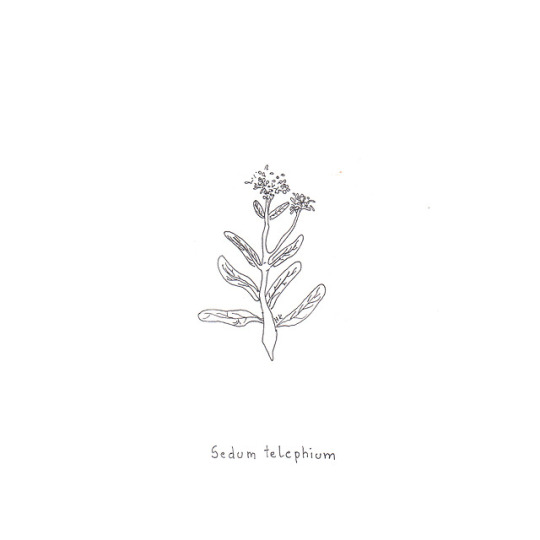
#scrophularia nodosa#sedum telephium#herbs#plants#nature#illustration#drawing#dra#pictur#minimalism#minimalist#back and white#linear#lineart#ilustracja#rysunek#obrazki#minimalizm#czarno biale#natura#zioła#ziółka#roślinki#rośliny#hello there#hk#hanna kaszewska#artists on tumblr
92 notes
·
View notes
Text
Plant Help
I got this plant the other day and the only thing I was told was to water it one day yes and one day no which doesn't sound super right so I was maybe hoping someone could help me out and let me know how to take care of it properly if I have it indoors. Thank you very much!


#Plant#Plants#Plant help#Succulent#Succulents#Im not good with plants#Plant doctor#Sedum lineare#Fand0maniac#Fand0maniac 333669
2 notes
·
View notes
Text
Dew on Petals, I Sit in the Morning Sun
An Ed and Stede flower/coffee shop AU!
Stede opens up a florist right next to Ed’s coffee shop. When Stede realizes he’s allergic to flowers, Ed offers a strange solution.
3 notes
·
View notes
Photo

A sea urchin stonecrop, sedum lineare. Another one I tend to stare at. by Angela3467
4 notes
·
View notes
Photo










A Survey of the Best Goldenrods for your Garden (Part I)
Introduction:
Why goldenrods?
There are currently 136 species in the genus Solidago, three more than the last time I checked the astereae lab. (see https://uwaterloo.ca/astereae-lab/) Most of these species are native to North America. For those who see them on the roadsides as masses of weedy generic golden flowers, it seldom occurs to them that from July through October they are most likely witnessing the blooms of a dozen or more species. By far the most common and most widespread and aggressive goldenrods throughout the Americas are those within the Triplinerviae group, which includes S. canadensis, S. gigantea, and S. altissima all of which can be maddeningly difficult to accurately distinguish even for the experts. Weedy though they may be, there are many plant lovers including those in the cut flower trade who understand the value of the majestic diamond and pyramidal flower forms of the canadensis types. A few hybrids have been developed for the cut flower trade that are generally not available to gardeners. Cultivars sold in the nursery like S. canadensis ‘Goldenbaby are smaller diploid forms that are less aggressive and more manageable. But on the whole, only recently do we see a wider variety of garden worthy species entering the nursery trade.
This is a great benefit to gardeners as many of these varieties are well behaved and very attractive plants that don’t at all resemble their weedy cousins except in their trademark golden flowers. And it must be said, while posing the question, why goldenrods, that they do not cause allergies as they have long been accused of doing. Their pollen is heavy and sticky and not carried in the wind. It has been guilt by association, a purely circumstantial case, while the real culprits (one of them ragweed) are off the hook. Goldenrods depend on insects for pollination.
Which brings me to the overwhelming benefit to growing goldenrods: they are one of the most important food sources in the late season for pollinating insects, especially bees. And goldenrod honey is delicious. Gardeners who are aware of the decline in bee species throughout the world, should straightaway run to their nearest online nursery and begin shopping for appropriate Solidago species for their region of the country. Lastly, in addition to providing you a pictorial and descriptive list of some of my favorite forms, I do so to show another advantage to growing goldenrods. It has to do with form. If you think about most perennials, you notice that many plants come in a variety of colors, but by and large represent a single form. Goldenrods do it the other way around--they come in only two colors, overwhelmingly yellow/golden and a couple of white ones, but they come in a wide variety of flowering forms. I hope to introduce the unfamiliar to some of the more striking and unusual ones, that should provide imaginative gardeners with a lot of landscaping and design opportunities.
1 & 2. Solidago bicolor. Also called silver rod, this is one of the white goldenrods well suited to the garden. Beloved by bees and has a light lily-like or honey suckle fragrance. Widely adaptable in Eastern North America, from the Maritimes south to Alabama and Georgia and as far west as Michigan and Illinois. In the wild, it is often sparse and underdeveloped and makes little impression. In cultivation it can make a rich flowering stand in late summer and early fall producing refreshing cream-colored wands over a 4 to 6 week period. Planted in a mass with Helenium, Sedum, Persicaria or Panicum it will have people asking, ‘what’s that’, and ‘goldenrod, really?’ Can sustain winter damage, but I’ve been growing it for 7 years and still have a few of the original seed grown plants. Reseeds will replace spent plants, and its slender profile won’t take up too much room in your garden. Full sun and part shade, where it can reach 4ft in height. Usually about 2 to 3 ft in full sun.
3, 4 & 5. Solidago riddellii. In my opinion this is the finest and most versatile goldenrod you can grow in your garden. It has an elegant and striking presence from May to November that is just as suitable for refined plantings as it is for the wild or natural garden. What you have here is a distinctive and elegant foliar profile, strong stems and rich, vibrant flowering. Another plus (image 5) is that the spent flowers retract neatly and the golden color of the phyllaries shines through, so there is no drab phase many flowers and most goldenrods pass through. Rather a pleasant golden/brown appearance enhanced by bright chartreuse leaflets below keep it shining through October, along with flashes of variegated colored fall foliage in shades of gold, orange, red, pink, purple and bronze. Finally soft-gray mounding seed heads complete the show in November. This long-lived clumper is a native of moist conditions, but it performed beautifully in the drought conditions that 2020 brought. So at the very least it can withstand the occasional drought. 2 1/2 to 3 1/2 ft in height. Difficult to find in nurseries or from seed. I purchased my seed from Ernst Conservation Seeds. The prices per pound are staggering and have gone up considerably since I first purchased seed in 2013 but smaller portions can be purchased at more affordable prices. Pollinator paradise.
6 Solidago rugosa ‘Fireworks’. This variation of S. rugosa was discovered in North Carolina in 1973 and registered as a cultivar in 1993. A more beautiful structural plant is hard to find, that and the thrilling lateral blooms cascading in all directions puts this one in my top 5 goldenrods. Likely a tetraploid as it blooms a good month later than the native S. rugosa that grow in Vermont, and it displays a tetraploid’s vigor. This plant is tough as nails and completely immune to flopping or collapse. You can park a bike against it (not saying you would but sometimes kids do the darndest things). The foliage is unremarkable and coarse (thus the name rough or crinkle leaf goldenrod), but notice in image 6 that even at bloom time it maintains most of its lower foliage, so you don’t have to hide ugly legs as you do with most Asters and many fall blooming perennials. You do have to watch this one over time. This slow spreader won’t take over your garden, but a single plant will spread outward into a 3 or 4ft stand, with its underground rhizomes working their way into other plants. Very long lived and hardy. It blooms so late in the north my experience is that it never has time to set seed before it is cut down, either that or it is sterile. Long and short you won’t be troubled with seedlings.
7 & 8: Solidago caesia ‘Blue Stem Goldenrod’. Here is one that can be grown in sun or shade, and a bright graceful addition it is to the shade garden given it blooms in August and September when very little is flowering in anyone’s shade garden. It has lax stems that tend to arch, cascading on slopes and showing off the lovely linear quality of its axillary blooms. Quite bushy in full sun, sparser in shade. This is one of the more delicate goldenrods with its slender purple stems coated with a blue powder, thus the name (reminding me of wild Concord grapes of childhood that ripen at the same time as these bloom) Image 8.
9 & 10 Solidago speciosa ‘Showy Goldenrod’. Put this one in your top 5 goldenrods as well. The shorter diploid version is pictured in image 9 and the much taller bolder tetraploid (image 10) that blooms very late in the North. Image 10 was harvested from the disturbed ground along the NJ Turnpike about 3 years after construction occurred. There are foliage differences as well. The tetraploids I harvested showed no dentation on the leaves (they were entire and longer and smoother than those of the diploids I harvested from Central Massachusetts). I believe most of what you will find offered in the wildflower nurseries such as Prairie Moon and High Country Gardens are the earlier blooming, shorter diploid types. But don’t ask the nurseries, they will neither know nor care. If it says to 3ft, it’s probably diploid, if it says to 5ft, possibly tetraploid. Some of the NJ populations were as tall as 6 1/2 ft, which of course makes a lot of difference if you are planning a garden. Majestic, non-invasive clumps, with quarter inch individual flowers give these full flower heads their showy quality and what I can only describe as a radiant glow from a distance. Another plus are the often deep red stems that intensify in color in the fall and make for a spectacular contrast with the cloud-like off-white seed heads. A stand of these in your pollinator garden is definitely worth growing.
12 notes
·
View notes
Text




Coleus (Plectranthus Scutellarioides) "Victorian Ruffles" (more sun vs less sun)
Sedum Lineare Variegata
19 notes
·
View notes
Text

🌿Sedum lineare variegata 🌿
#succulents and cacti#animals#my gifs#suculento#nature#funny gifs#succuholic#flores#cactos#lol#succulent#succubae#succulents#succulentgarden#succubi#succulove#succuaddict#suculovers#suculent plant#suculove#suculentas#suculencia#suculentslover#cacti and desert plants
9 notes
·
View notes
Photo

Our Sedum Carpet Lineare is growing like crazy right now. 🤯❤️ This particular 2 pack is on its way to San Francisco. Succulents travel best with a buddy so we sell just about everything in at least a set of 2. 👯♀️👬👫🌱📦 #growbabygrow * * * #harddysucculents #nurseryfresh #sedum #succulents #buddysystem #plantmail https://ift.tt/2UCPhxi
10 notes
·
View notes

